Choreography: Diane Montgomery
Suite Directors: Jay Snyder, Sallie Varner
This suite of dances utilizes polka, schottische, waltz, and clogging steps tap clog, waltz clog and Appalachian clog.
- Running Set: Orange Blossom Special
- Schottische: You Are My Flower
- Polka: Devil's Dream
- Waltz: In the Blue Canadian Rockies
- Clog: Cripple Creek
- Finale: Cripple Creek, Boil That Cob Down, Ragtime Annie, Turkey in the Straw
Choreography: Terl Robinson, Karen Robinson
Suite Director: Deryl Keney
Favorite couple dances from Germany and Austria.
- Henkenhagener Kegel
- Zillertaler Ländler
- Sauerlander Quadrille
- Haufbrau Haus Ländler
Choreography: John Isursa, Jenny Isursa
Suite Directors: Bill Pool, Cherie Trine
The Basque people of Euzkadi (southern France and northern Spain) have a strong sense of ethnic identity, with an extremely old culture. Over the centuries they have maintained a separate identity and a unique culture. Basque dance, like the rest of their culture is very different from other ethnic dance forms. An account of the Basque people's dances from the first century B.C. tells of the men drinking then seeing who can jump the highest and land on their knees.
- Ingurutxuak: Medley of couple dances
- Axuri Beltza: Women's singing dance
- Lapurdi'Ko Makil Dantza: Stick dance from Lapurdi
- Scarf Dance
- Sagar Dantza: Women's apple dance
- Uztai Txiki Dantza: Hoop dance
- Waltz
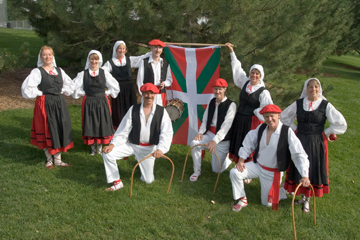
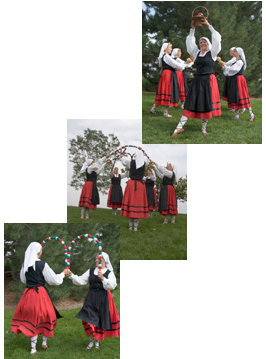
Choreography: Jenny Isursa
Suite Director: Cherie Trine
A suite of commonly performed Basque dances done only by women.
- Axuri Beltza: A dance that begins very slowly, then brightens as the women dance in a circle and sing that they aren't yet too old to dance
- Sagar Dantza: Apple dance
- Hoop dance: An energetic dance done with brightly decorated hoops
Choreography: Ali Bozatli, Murat Kinikoglu
Suite Director: Bill Pool, Jay Snyder
These men's dances from the region of southeastern Turkey near the city of Bitlis are characterized by tightly formed lines and looseness of torso. Life in this region is often difficult and the dances reflect a certain fierceness and challenge in the style and movements. In the beginning, the men sing a song about their city of Bitlis, then progress through a series of dances that build in intensity to the final "fighting" dance where two lines of dancers challenge each other with the slapping figures of a mock battle. The zurna and davul provide musical accompaniment.
- Uē Ayak
- Meyroke
- Sepe
- Garzani
- Papuri
- Harkusta
Choreography: Bora Ozkok, Murat Kinikoglu, Ercument Kilic
Suite Directors: Deryl Keney, Bill Pool
Dances from the Black Sea coast of northern Turkey. The shimmying movements reflect the shimmering of the fish in the sea, the main source of livelihood for these people, calls imitate sounds heard on the sea and the "horon" style arms seen in the men's dance mimic the corn which grows abundantly in this region. These dances are done by the Laz people, an ethnic minority of Turks who inhabit this region.
- Kiz Oyünü, Karadeniz Kiz: Women's dances
- Sallama (and others): Men's dances
- Arhavi Canlisi: A group dance which starts with a humorous song

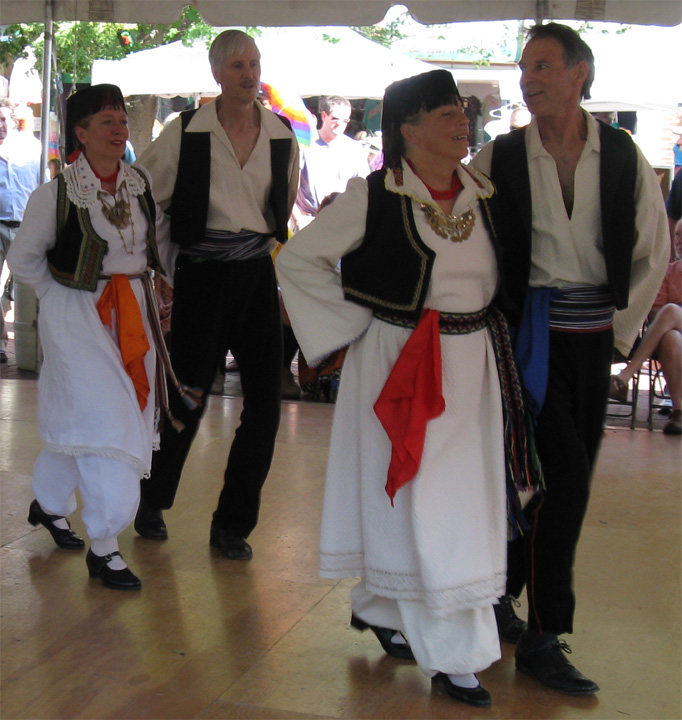
Choreography: Barry Glass
Suite Directors:Wendi Kiss, Sallie Varner
This suite joins and contrasts dance styles of the three major religious groups found in Bosnia: Muslim, Orthodox and Catholic. The Catholic dances Pleti Kolo, Poigrajte and Djuture tend to be somber and constrained, whereas the Muslim (urban) and Orthodox dances add a brighter note to the suite. Listen for the unusual dissonances common to Bosnian singing.
- Na Kordunu: Entrance
- Pleti Kolo: Women's dance
- Poigrajte Bile None: Women's dance, men join in the singing
- Djuture
- Treskavica Okolo
- Tapkolica
- Treskavica Sitna
- Staro Bosnatsko Kolo from Glamoc: Silent dance
- Mišnjaca / Licki Tanac
Choreography: Barry Glass
Suite Director: Sallie Varner
Dances from three regions of northeastern Croatia. The first four dances are from Slavonia, these dances are very characteristic of Croatian dances, with lots of happy Tamburica music, singing and interesting footwork. The middle two dances are from the region of Medgimurje, a region along the border between Croatian and the old Austro-Hungarian Empire. This region has seen much military activity over the centuries and the dances tend to reflect this by being heavier than typical Croatian dances and more militaristic in styling. The last two dances are from the region of Prigorje. These dances are happy, playful and filled with the Drmeš, a bouncing step which is the most characteristic step of Croatian dancing.
- Ajde Noga za Nogamo
- Oj Rasticu Šušnjati
- Presjekace
- Kolo from Valpovo
- Raca Plava
- Baroš oj Barica
- Šroteš
- Krici Krici Ticek
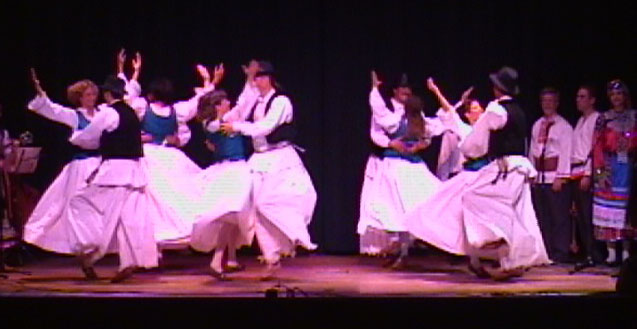
Choreography: Tibor Toghia, Joe Kiss
Suite Directors: Wendi Kiss, Sallie Varner
This suite presents a cycle of dances from Délalföld. This richly folkloric region located in the southern great plain of Hungary includes the city of Szeged. The Délalföld region has been settled since prehistoric times and was the center of the Hun empire in the 9th century. The suite starts with an Ugros or "jumping" dance in both line and couple versions, followed by a Lassú Csárdás and concluding with a Friss Csárdás. Notable are the mens' wide-legged trousers, or gatya.
- Ugros
- Lassú Csárdás
- Friss Csárdás
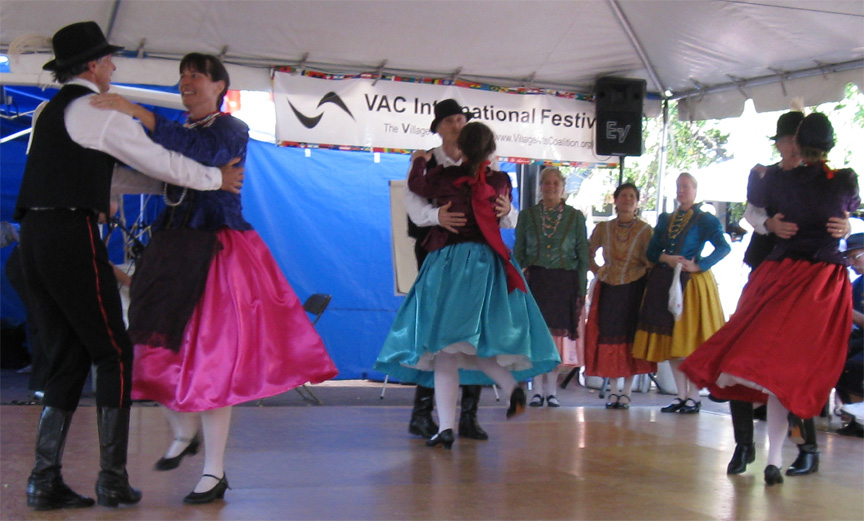
Choreography: Ali Bozatli, Murat Kinikoglu, Bora Ozkok
Suite Director: Jay Snyder
The opening and closing dance is from the wedding celebration in the villages around Elazig, a large city in eastern central Turkey. The dancers, with candles, escort the bride from one part of the village to another during the celebration. Halay and Keçiko demonstrate Kurdish dance styling, characteristic of southeastern Turkey. The song that accompanies the dance Nurey is a love song to the beautiful Nurey. Music for this suite is played on the zurna and davul.
- Çayda Çira
- Halay
- Keçiko
- Delilo
- Çayda Çira
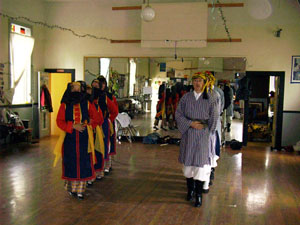
Choreography: Katina Savvidis, Dan Prendergast
Suite Director: Deryl Keney, Bill Pool
Greeks settled very early in regions of Asia Minor, now modern Turkey, and remained there until the 1920's. These settlements were geographically isolated from the mainland of Greece for most of their history and hence evolved a culture little influenced by other tribes and civilizations. Their language is still strongly linked to the dialect of Homeric Greek, and the songs and dances reflect the more primitive quality of their history. In the 1920's, the governments of Greece and Turkey agreed to an exchange of populations and the Greeks who had been living in Asia Minor resettled in Thrace, Macedonia, and in the vicinity of Athens. These Greeks maintained a strong tie to their traditional songs, dances, and rituals that they brought from their former villages. The dances in this suite are from two regions: Cappadocia, in southwestern Turkey, and Pontos, along the Black Sea coast. It is interesting to compare these Pontic dances with the Turkish Black Sea dances and note the many similarities.
The suite begins with two dances from Cappadocia. Both are laments to the loss of their homes that were left a generation (or more) ago. Large wooden spoons are played by the women as rhythmic accompaniment to the dance. Following are two lively dances from Pontos, showing the fierce pride of the dancers. In the final dance, the leader calls out the names of the steps for the other dancers to follow.
- Dirge
- Spoon Dance
- Seranitsa
- Kotchari
Choreography: Katina Savvidis, Joe Graziosi, Sallie Varner
Suite Director: Sallie Varner
These dances represent the islands of Greece, rather than the mainland, and are characterized by light, proud movements and styling reminiscent of the feel of the sea.
- Zervos/Nizamikos
- Issios
- Ballos
- Pentozali
- Sousta
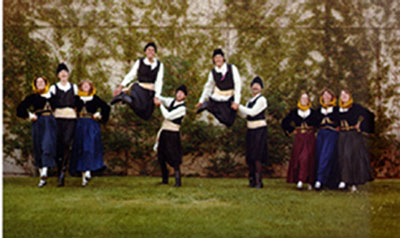
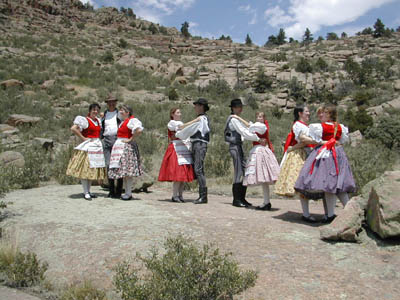
Choreography: Joe Kiss
Suite Director: Rebecca Mann
Dances from the Northern Great Plain and Upper Tisza regions. The first dance is a men's stick dance or "botolo" from the northern area of the Great Plain. The hurdy-gurdy or "tekerö" instrument heard is very typical of the region, as are the men's costumes of full gaucho-like pants, called "gatya." The next dance, a girl's karikázo or a cappella circle dance is from Zemplén County in the Upper Tisza region of Hungary and is an original choreography by Sándor Timar. Karikázo were not traditionally considered as dance and could be performed during Lent when dancing was discouraged. The women sing to accompany their dances; some of these songs are humorous and even a bit bawdy. The final set of dances is from Szatmar county, also in the Upper Tisza, in particular the area around the village of Nagyecsed. The first is a "verbunk" or men's dance. A slow couples dance or "csendes csárdás" follows, flowing into a fast or "friss csárdás," reflecting the lively style of the region. Of particular interest are the men's "csapo," or rhythmic slapping sequences throughout the dance, becoming more energetic as the dance concludes.
- Botolo
- Zempléni Karikázo (Women's Singing Dance)
- Szatmári Táncok -- Szatmári Verbunk, Csendes Csárdás, Friss Csárdás
Choreography: Mary Wallace
Suite Directors: Deryl Keney and Sallie Varner
This suite is from the Agri (Ararat) region of southeastern Turkey. Kina Gecesi, meaning "Henna night," refers to the second evening of a three-day wedding event in modern rural Turkey. On this evening, the grandmother of the bride applies henna to the hands of the bride to signify her newly married status. Designs on the hands are produced with string, lentils and coffee beans. This ritual takes place in the bride's home with her female relatives and young friends of the village celebrating the henna night with singing and dancing. Meanwhile, the groom and his male relatives and friends are gathering at his home for the ritual shaving, as well as singing and dancing. The costumes of the women are representative of modern rural Turkish dress: many layers of clothing in bold, bright colors. The musicians play the zurna, a primitive double-reed instrument, and the davul, a large drum.
- Kaz-Kaz: Kurdish nonsense song comparing a foolish girl to a goose
- Zeyno
- Basso
- Hane
- Papuri Kiz
Choreography: Joe Kiss
Suite Directors: Wendi Kiss, Sallie Varner
These dances from the Hungarian-speaking village of Lorincréve in Transylvania (also called Leorint) open with two songs about lost love. In the first dance, a rhythmically complex dance called Pontózo, the men show off using fast footwork combined with percussive slaps. The men and women join to dance a slow Csárdás called Öreges (old folks' dance), followed by a lively Szapora. The suite finishes with a return to the exciting Pontózo, with the women joining the men. Listen for the women calling out csujjogatás or rhyming dance calls.
- Megyek az Uton Lefelé (song)
- Kék Ibolya (song)
- Pontózo
- Öreges
- Szapora
- Pontózo
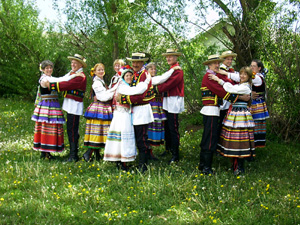
Choreography: Michael Levinsky with revisions by Laura Hanson (Courtesy of Michas Polish Folk Dance Ensemble) and Sallie Varner
Suite Director: Sallie Varner
Courting and wedding dances from the area around Lublin in Eastern Poland. The suite includes dances showing traditional courtship and marriage rituals.
For St. George's Day, young women make candle wreaths which they set afloat on the river. Young men may hide nearby to watch, then try to catch the wreath of the woman they would like to marry. Thus, the women will make sure that when they show off their wreaths to one another, anyone who might "happen" to be nearby might be able to see it as well, just "in case" someone special is watching.
The marriage celebration generally lasts for several days, with lots of dancing and singing. Often the bride and groom will be kept apart for much of the ceremony. Thus in a dance like Cygan, done before the wedding is complete, the bride and groom do not dance together.
It is tradition in this area that a bride will have as many children as she hears Cuckoos on her wedding day. This is reason the song Kukuleczka is sung to the bride.
The wedding walc/oberek includes several customs, such as keeping the
bride and groom separated; the capping ceremony, in which the bride's
maiden headdress is removed and replaced with the cap of a married woman
(no woman is truly married in the eyes of the village until she has been
capped); and a traditional toast to the new couple.
- Kujawiak
- Cygan
- Song (Kukuleczka)
- Walc/Oberek
- Mach
Choreography: Sallie Varner
Suite Director: Sallie Varner
In Bulgaria, the Horoto is the village square where people go to meet, sing, play music and dance. Praznik is the Bulgarian word for a festival or celebration. In this suite, entitled "Praznik na Horoto," Storm Mountain shares traditional dances from the region of Trakija in central Bulgaria as they might be done during a village celebration. Dancers are happy, relaxed and enjoy the music and dance as they enjoy each other's company. The dances performed are called only by the names of the traditional folk rhythm in which the music has been written:
- Pravo: an even rhythm, usually counted in 2
- Gankino: an uneven rhythm with 11 beats to the measure
- Pajduko: an uneven rhythm with 5 beats to the measure
- Trite Pāti: an even rhythm
- Rācenica: an uneven rhythm with 7 beats to the measure.
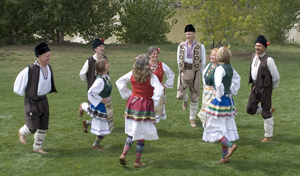
Choreography: Nicolaas Hilferink
Suite Director: Cherie Trine
Folk dances from the regions of Oltenia and Muntenia in southern Romania are characterized by their enthusiasm and high energy. Dancers are proud of their fast and intricate footwork, often using stamps and slaps to accent or syncopate the rhythms of the music. Vocal calls are used to add to the excitement. The dances presented in this suite depict basic village dance styles and rhythms found in southern Romania.
- Sirba
- Balta
- Hora: A slower women's dance
- Rustemul: known for its distinctive, uneven rhythm
- Briul: named for the belt-hold used by the dancers.
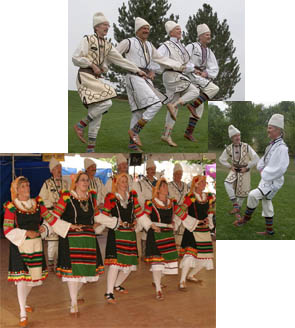
Choreography: Petur Iliev
Suite Director: Cherie Trine
From the Sop (pronounced Shope) region in northwestern Bulgaria. Like many mountainous areas in eastern Europe, this region produces dances which are quite rigorous and energetic; the footwork is fast and the styling distinctive. The dancers like to tease, flirt and show-off while they dance.
- Rācenica: Men's show-off and entrance dances
- Women's singing dance
- Kopanica
- Četvorno
- opka Rācenica
